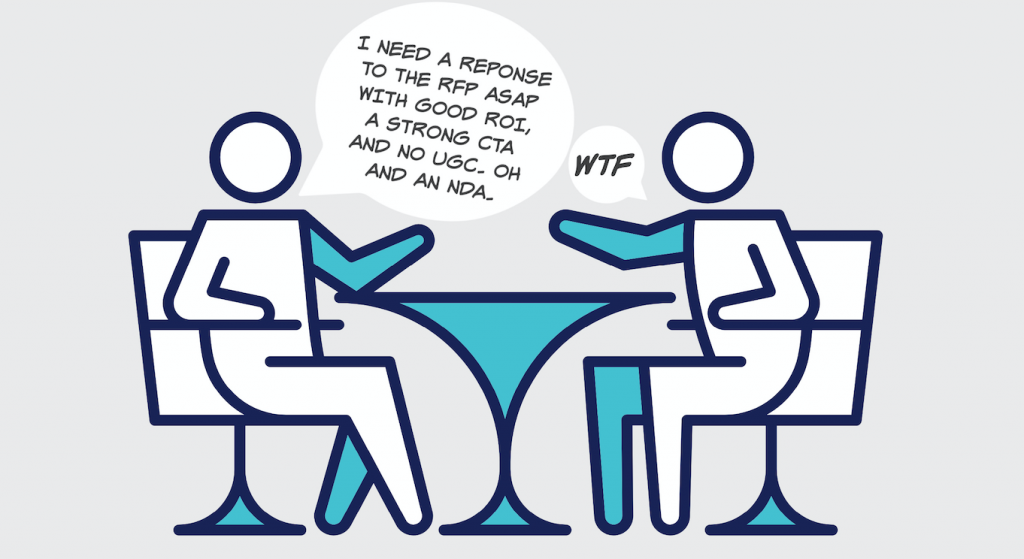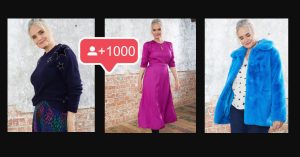Bookmark this page for when the abbreviations get too much
Get familiar with digital marketing and content creator terms and acronyms now, and you’ll feel much more prepared when you go into meetings. You don’t want to be frantically Googling things under the desk or having to ask for things to be explained – you want to feel cool, calm and collected. Here’s your content creatiion and digital marketing dictionary:
ASA: Advertising Standards Agency. Another government body, and one you will be hearing from if you make claims about a product that aren’t true, or overstate its power and influence. They also set important guidelines about disclosing advertising on social media. They have the power to publicly issue fines, so brush up on their requirements whenever you can.
Boilerplate: Boilerplate copy refers to a standard bit of text that’s usually provided by a brand for liability reasons. For example, it might be brief T&Cs on a competition, or a generic blurb about the limitations of an offer. It could also be a little bit of information about the brand and what they offer, too.
CMA: Competition and Markets Authority. The CMA are a government body who exist to safeguard consumer rights. You’re unlikely to hear much from them as a creator, but they have been known to step in on certain issues around price gouging, disclosing paid partnerships and preventing mergers that would cause a monopoly.
Conversion: Usually calculated as a percentage, conversion refers to the amount of people you turn into customers, subscribers or followers when provided with a CTA. Say you have 100,000 followers, and 6,000 of them will buy the iPhone case you post about. That gives you a conversion rate of 6%. It’s usually a single-digit percentage, and often below 5%, especially if you have more followers.
CTA: Stands for “call to action”. A brand might ask you to add a CTA to the end of your sponsored post for them, something like “Follow @brand for more info” or “Click the link in my bio”. It’s about providing an onward journey for users. You can also ask brands what they’re hoping the CTA will be if you’re looking for clarification on their goals.
CTR: Click through rate! You might be asked what your usual CTR is, and this means how many actually click through onto a link that you put in front of them, whether that’s in a blog post or a in-feed post.
Deliverables: This refers to content that you’re expected to keep up your end of the deal. It might be YouTube videos, Instagram posts or a TikTok. It can also refer to requirements for things you need to send over, like a media kit or your rate card – we’ll get into those later…
EOD: End of day. If someone asks for something by EOD, make sure you know what time zone they’re in, but it usually means 5pm their time.
Engagement: Again, this is usually calculated as a percentage. Engagement refers to how many of your followers actively engage with your content, and it’s different on each platform. It refers to action, not passivity: so liking or commenting, watching a whole video, sending on to others, etc.
KPIs: Key performance indicators. When starting a project, it’s always good to know what the KPIs are, as they’ll be different for every brand. Maybe they’re looking to gain more followers on their page, maybe to get more newsletter sign-ups, or to sell tickets to an event. Ask if they don’t tell you, as this is how they will measure the success of your partnership.
Media kit: A media kit is a pack or a deck you can put together that has all your vital info in one place; total aggregated followers, examples of your past work, references and so on.
NDA: Non-disclosure agreement. You might be asked to sign an NDA before a brand shows you a currently unreleased product or service, or in the early stages of a partnership. You must read it carefully, but by signing, you promise not to reveal anything that’s detailed in the contract – trade secrets, details of a project, that kind of thing. If you breach it, you can be sued, so don’t sign without understanding the weight of it.
Organic: Organic reach or organic growth refers to the people you reach without paying to promote your content through adverts.
Rate card: A rate card is your personal list of pricing for different partnerships. You should not advertise this document, and you should only send it to brands who have expressed a genuine interest in working with you. It’s fine to put prices as “from £xx” or a range, but be prepared to explain why.
Reach: Your reach is the aggregate of all your followers and subscribers across all platforms.
ROI: Return on investment. The investment might be how much they pay you for a project, and the return will be what that project gives them: more sales, more followers, greater exposure, etc.
UGC: User-generated content. This refers to any content that’s not generated by a brand. For example, a brand might ask a group of creators to respond to a challenge for a partnership – what you all create is user-generated content. However, it more often refers to unpaid content, so asking your followers to send in a selfie and tag a brand to win a prize would also be UGC.
Waiver: A waiver is a form that by signing, you waive some rights. The most common one you’ll see is a brand may ask you to sign one to waive your rights to an image or video you took so they can use it commercially, or so they can use quotes from you to promote a product.







